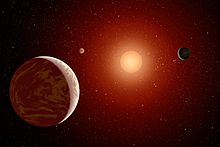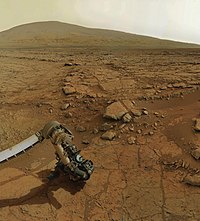This article needs additional citations for verification. (April 2017) |

 |
| This article is one of a series on: |
| Life in the universe |
|---|
| Outline |
| Planetary habitability in the Solar System |
| Life outside the Solar System |
| Habitability of... |
The theorized habitability of red dwarf systems is determined by a large number of factors. Modern evidence suggests that planets in red dwarf systems are unlikely to be habitable, due to their low stellar flux, high probability of tidal locking, likely lack of magnetospheres and atmospheres, and the high stellar variation such planets would experience. However, the sheer number and longevity of red dwarfs could provide ample opportunity to realize any small possibility of habitability.
Current arguments concerning the habitability of red dwarf systems are unresolved, and the area remains an open question of study in the fields of climate modeling and the evolution of life on Earth. Observational data and strong statistical arguments suggest that red dwarf systems are uninhabitable for indeterminate reasons.[1] On the other hand, 3D climate models favor habitability[2] and wider habitable zones for slow rotating and tidally locked planets.[3]
A major impediment to the development of life in red dwarf systems is the intense tidal heating caused by the eccentric orbits of planets around their host stars.[4][5] Other tidal effects reduce the probability of life around red dwarfs, such as the lack of planetary axial tilts and the extreme temperature differences created by one side of planet permanently facing the star and the other perpetually turned away. Still, a planetary atmosphere may redistribute the heat, making temperatures more uniform.[6][5] However, it is important to bear in mind that most flare stars are red dwarfs (although this does not mean all red dwarfs are flare stars), and their flare events could greatly reduce the habitability of their satellites by eroding their atmosphere (though a planetary magnetic field could protect from these flares). [7] Non-tidal factors further reduce the prospects for life in red-dwarf systems, such as spectral energy distributions shifted toward the infrared side of the spectrum relative to the Sun and small circumstellar habitable zones due to low light output.[5]
There are, however, a few factors that could increase the likelihood of life on red dwarf planets. Intense cloud formation on the star-facing side of a tidally locked planet may reduce overall thermal flux and drastically reduce equilibrium temperature differences between the two sides of the planet.[8] In addition, the sheer number of red dwarfs statistically increases the probability that there might exist habitable planets orbiting some of them. Red dwarfs account for about 85% of stars in the Milky Way[9][10] and constitute the vast majority of stars in spiral and elliptical galaxies. There are expected to be tens of billions of super-Earth planets in the habitable zones of red dwarf stars in the Milky Way.[11] Investigating the habitability of red dwarf star systems could help determine the frequency of life in the universe and aid scientific understanding of the evolution of life.
- ^ Waltham, David (January 2017). "Star Masses and Star-Planet Distances for Earth-like Habitability". Astrobiology. 17 (1): 61–77. doi:10.1089/ast.2016.1518. PMC 5278800. Retrieved 30 July 2024.
- ^ Yang, Jun; Cowan, Nicolas B.; Abbot, Dorian S. (27 June 2013). "STABILIZING CLOUD FEEDBACK DRAMATICALLY EXPANDS THE HABITABLE ZONE OF TIDALLY LOCKED PLANETS". The Astrophysical Journal. 771 (2): L45. arXiv:1307.0515. doi:10.1088/2041-8205/771/2/L45. Retrieved 30 July 2024.
- ^ Yang, Jun; Boué, Gwenaël; Fabrycky, Daniel C.; Abbot, Dorian S. (25 April 2014). "STRONG DEPENDENCE OF THE INNER EDGE OF THE HABITABLE ZONE ON PLANETARY ROTATION RATE". The Astrophysical Journal. 787 (1): L2. arXiv:1404.4992. doi:10.1088/2041-8205/787/1/L2. Retrieved 30 July 2024.
- ^ Barnes, Rory; Mullins, Kristina; Goldblatt, Colin; Meadows, Victoria S.; Kasting, James F.; Heller, René (March 2013). "Tidal Venuses: Triggering a Climate Catastrophe via Tidal Heating". Astrobiology. 13 (3): 225–250. arXiv:1203.5104. Bibcode:2013AsBio..13..225B. doi:10.1089/ast.2012.0851. PMC 3612283. PMID 23537135.
- ^ a b c Major, Jason (23 December 2015). ""Tidal Venuses" May Have Been Wrung Out To Dry". Universetoday.com. Archived from the original on 26 March 2023. Retrieved 9 April 2012.
- ^ Wilkins, Alasdair (2012-01-16). "Life might not be possible around red dwarf stars". Io9.com. Archived from the original on 2015-10-03. Retrieved 2013-01-19.
- ^ "Habitable Exoplanet Observatory (HabEx)". www.jpl.nasa.gov. Archived from the original on 2019-10-08. Retrieved 2020-03-31.
- ^ Yang, J.; Cowan, N. B.; Abbot, D. S. (2013). "Stabilizing Cloud Feedback Dramatically Expands the Habitable Zone of Tidally Locked Planets". The Astrophysical Journal. 771 (2): L45. arXiv:1307.0515. Bibcode:2013ApJ...771L..45Y. doi:10.1088/2041-8205/771/2/L45. S2CID 14119086.
- ^ Than, Ker (2006-01-30). "Astronomers Had it Wrong: Most Stars are Single". Space.com. TechMediaNetwork. Archived from the original on 2019-09-24. Retrieved 2013-07-04.
- ^ Staff (2013-01-02). "100 Billion Alien Planets Fill Our Milky Way Galaxy: Study". Space.com. Archived from the original on 2020-05-09. Retrieved 2013-01-03.
- ^ Gilster, Paul (2012-03-29). "ESO: Habitable Red Dwarf Planets Abundant". Centauri-dreams.org. Archived from the original on 2017-01-18. Retrieved 2013-01-19.